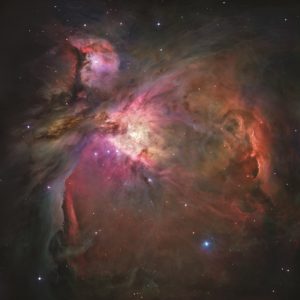Winter is the season of Orion. As darkness falls, this constellation stands tall in the southeast, about halfway up the sky, and you’ll find it migrates higher and more southerly as winter progresses. Orion has it all: a clearly recognizable pattern, bright and colorful stars, and a rich mythology spanning many diverse cultures.
And there is more. Within the boundaries of this constellation, you can see proto-stars in the process of creation, young stars, middle-aged stars, and a star close to the end of its life, all with your unaided eyes.
What do the stars of Orion depict? The answer depends on whom you ask. In 1979, archaeologists discovered a Paleolithic ivory carving in Germany dating back about 35,000 years, which appears to show the stars of Orion. Unfortunately, we don’t know what story the artist wished to tell us about these stars.
But cultures whose writings have survived the millennia can still speak to us. The Babylonians saw in this arrangement of stars a heavenly shepherd, while ancient Sanskrit hymns sing of it as a deer. The Hindu god Shiva has many aspects, including the cosmic dancer, also associated with Orion.

Indigenous peoples of our continent have many wonderful stories to tell of Orion. One Inuit legend describes three hunters (where you may be used to seeing the three stars of Orion’s belt) on a sledge (Orion’s sword) pursuing a bear (the bright red star Betelgeuse). The Chinook see two canoes competing to catch a salmon in the nearby Big River (also known as the Milky Way). The Crow, Lakota, and other Great Plains peoples saw a giant celestial hand. The three belt stars form a wrist, with the hand extending “down”; Orion’s sword is an outstretched finger.
There is also the harpooner of heaven that the Kwakiutl of the Pacific northwest saw; or al-Jabbar, the Giant, of 10th-century Islamic astronomy; or the magic archer of old Hungarian legends. And that brings us to Orion, the great hunter of Greek mythology who lives on in the constellation that bears his name.
There are many variations of his story, most of them violent and ugly. As far as the legends of this constellation, the one about the cosmic dancer is much nicer.
One reason for a closer look at Orion is the chance to see a stellar nursery. First, find what observers now refer to as Orion’s belt — the three bright stars in a close row. Below the belt, you’ll see his sword. It will look like another line of stars but not as bright and obvious as the belt. Now look closer at the sword and its stars. One of them is not a star. It’s a fuzzy patch, hard to see directly but more apparent with slightly averted eyes, and distinctly different from the pinpoint stars around it. That is the Orion Nebula, also known as Messier 42, M42, or NGC 1976.
M42 is an emission nebula, a vast cloud of glowing gases about 1,300 light-years away. The atoms of the gases have been ionized (stripped of their electrons) by intense radiation. That radiation comes from newly formed and furiously burning stars within the nebula. And these stars are themselves formed from collapsing pockets of the nebula’s gas. The glow is both a sign of star birth and the inevitable death of the nebula — the young stars’ powerful radiation eventually destroys the very cradle of their creation.
If you can look through a small telescope, you’ll see the Orion Trapezium Cluster, four stars embedded in the glow of the nebula. Galileo was the first person to see them when he began studying the nebula with his early telescope.
They are very young stars at around 300,000 years old and they are siblings. That is, because they were formed from the same nebula, they share a similar chemistry (every nebula has its own ratio of elements, almost like a fingerprint). Gravitational interactions will eventually break this family apart, sending the stars on their own trajectories around the Milky Way, most likely never to meet again.
Our Sun began in a stellar nursery just like the Orion Nebula. And our own stellar siblings are out there somewhere. Some astronomers are trying to find them by looking for stars with chemical signatures like the Sun. Every atom in our bodies was once part of that original nebula, too — we are made of the matter that didn’t get drawn into the proto-Sun. When we look at M42, we are looking back at our own past. Clear skies!



